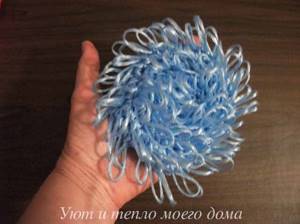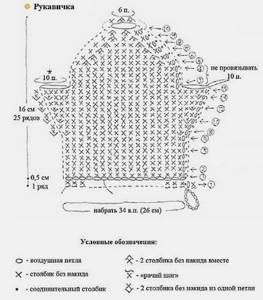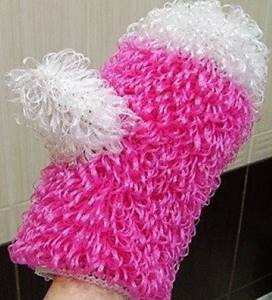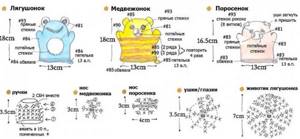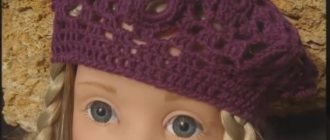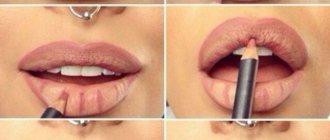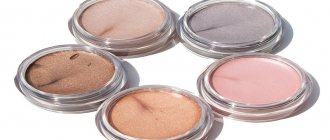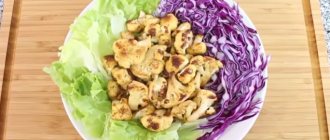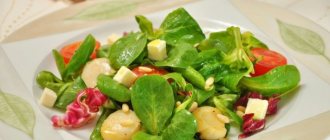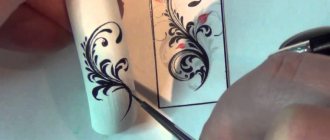Crochet washcloth with elongated loops
- We knit a chain of 40 chain stitches and connect them together to make a ring. The diameter of the resulting ring will be the size of the product. You can knit a large washcloth by adding loops if necessary.
- Next we knit seven rows with single crochets.
- On the eighth row we knit elongated loops; they must be located behind the washcloth.
- Determine the length of the washcloth yourself. This is purely individual.
- After the required length of the product is ready, we knit two chains of air loops separately and connect them into a ring. We knit the edge of the washcloth, as if making an edging. Those same two chains are handles. We make the length of the washcloth as needed.
- The finished washcloth must be turned inside out.
- We wash the finished product and pour boiling water over it to make it soft.
Children's washcloth toy
A crocheted washcloth (step-by-step instructions for beginners are presented below), crocheted in the shape of a hedgehog, will not be difficult if this pattern is used when knitting.
Knitting step by step:
- To start knitting, you should knit a chain of 32 chain stitches and connect the first and last loops.
- The first 2 rows are knitted with single crochets.
- Then 30 rows are knitted with “fur” (in the manner described above).
- To knit the muzzle you will need white. 5 rows are knitted with simple stitches, after which 4 loops should be decreased in each row.
- The thread is cut and secured. The eyes and nose are decorated with threads of the main color using a needle.
Berry-shaped washcloths also look gorgeous.
How to knit
A washcloth knitted from polypropylene threads, but not too thick, would be ideal and tough. It is best to purchase twine that resembles thin braid. It is very easy to knit with one thread. For an average size washcloth you will need about 350 meters of thread. It is better to buy such twine with a reserve, so that you do not have to look for threads that match the color and thickness for the product if there are not enough of them. Such polypropylene threads are sold in any hardware or handicraft store.
It is better to choose a medium crochet hook, not very thin (about No. 4) and its head should be smooth, otherwise a sharp hook will tear the thread while knitting.
Knitting elongated loops
A novice needlewoman, in order to start knitting such a product, must first learn a lesson on knitting elongated loops. Subsequent knitting will be easy . The diagram can be found on the Internet.
So, the step-by-step execution is as follows:
- We knit air loops. The quantity does not matter as we are learning.
- Then we knit four rows of single crochets.
- Having made an air loop by lifting the hook, then we knit a single crochet.
- We knit a loop by inserting the hook into the previous row.
- Hold the thread coming from the ball with your thumb from below and make a large ring
- Insert the hook into the base loop that was knitted earlier.
- We grab the thread, pull it through the base, grab it again and pull the thread through three loops.
- You need to knit this way until the entire fabric is covered with shaggy loops.
MK for beginners on crocheting washcloths according to patterns
We will need:
- a hook of medium thickness (for example, No. 4);
- polypropylene threads (they are sold in the same place as regular knitting threads).
When choosing a hook, you must take into account that if the head of the hook is sharp, it will tear the polypropylene fibers.
The color of the threads can be selected according to your own desire and taste. To create a good volume of the washcloth, you can take two threads at once.
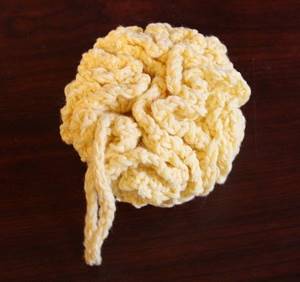
Let's look at the step-by-step instructions with a description of the work
To begin with, two threads are folded and a chain of air loops is made. For a chain width of 10 cm (excluding elongated loops), you need a chain 20 cm long. We connect the resulting chain of air loops into a ring and tie the ring with single crochets. We knit 4 rows.
Pulling out the loops: you can continue knitting with single crochets, but it will be faster to knit with double crochets, and the loops must be pulled out.
Scheme:
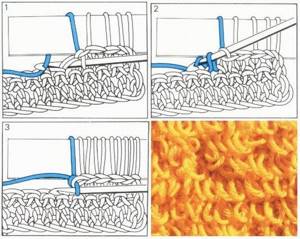
How to pull out loops:
- The working thread is thrown onto the hook;
- The hook is brought into the loop of the previous row;
- Grab the working thread from both sides, thus forming a loop on your finger;
- Pull two threads through the loop of the row and slip them off your finger. There are four loops left on the hook;
- The working thread is caught with a hook and pulled through two loops;
- The working thread is grabbed again and pulled through the two loops that remain on the hook;
- When a row is knitted, you need to turn the washcloth inside out to make it easier to knit (example in the photo).
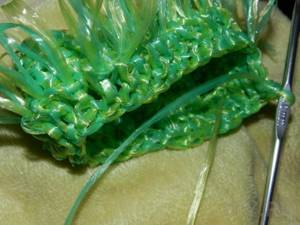
Then you need to knit with double crochets, pulling out the loops. You need to knit until the washcloth reaches the required length.
The last rows are knitted in single crochet stitches, without pulling out the loops.
How to knit handles:
The handles for the washcloth can be knitted separately and then attached to the washcloth, but you can also knit them without breaking the thread.
We knit the first handle after the main fabric.
In the first loop of the row you need to knit a single crochet, and from the resulting loop, tie a chain with air loops. The number of air loops regulates the length of the handle. We secure the end of the chain by knitting single crochets in the middle of the washcloth. Once the handle is secured, you can begin tying the handle. You need to tie it with a single crochet. Knit 2-3 rows. Upon completion, the loop is pulled out and the knot is tightened. The thread can be cut.
The second handle is knitted according to the principle of the first handle. You need to tie the threads to the edge of the washcloth and secure it. We knit a chain of air loops (the number is the same as on the first handle), tie 2-3 rows with single crochets and secure.
When finished, turn the washcloth with the shaggy side out. An example of the resulting washcloth can be seen in the photo below.
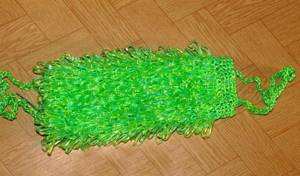
As you can see, you only need to know the types of loops and have a desire to learn, and our article CROCHETING WITH DIAGRAMS AND DESCRIPTIONS FOR BEGINNERS (TIPS AND SECRETS IN PRACTICE) will help you with this.
Washcloth-mitten
It is very convenient to use a washcloth not in the form of a cloth, but in the form of a mitten. Sisal or linen threads are used to make it. But it’s better not to use nylon here, as it imparts rigidity to the product. Crocheting such a mitten is easier than knitting. There is no need for painstaking efforts to knit a finger. Even a novice craftswoman can figure out this scheme if desired. So, step-by-step instructions for knitting mittens:
- We knit a chain of 30 chain stitches. If you need a small mitten, then 25.
- We knit a single crochet tightly in a circle. Starting each new row we knit an air loop. The size of the product is made at will.
- When the required size is reached, we connect the upper part of the mitten. To connect, the top and bottom posts are knitted together.
- We sew all the details.
Mitten - washcloth
For knitting creative washcloths, it is preferable to use natural materials. It can be cotton, sisal or linen. Synthetic yarn will also work.
Step by step knitting:
- You should start with a chain, the length of which is determined by the size of your hand.
- Knitting goes in circles. Single crochets are used.
- Fabrics for fingers (or one finger) are also knitted in a circle.
- For a child, a knitted mitten is designed in the shape of some funny animal. How to do this is shown below.
|
If the mitten is knitted from artificial yarn, then elongated loops will look more beautiful. |
| |
| |
Bath sponge
Are you a sauna lover? Bring the necessary accessory with you! In order to knit a bath sponge, you can use: flax, bast or sisal. It is made in various designs and can be fluffy, round or in the form of a mitten. To knit a round bath accessory, a novice needlewoman does not need superpowers.
- We knit 7 air loops, knit them, closing them in a circle.
- We knit the rows with single crochets.
- The width of the washcloth will increase as you knit. When the diameter is 20 cm, we begin the reduction in each row.
- We knit five rows like this. As a result, the product should look like a “cup”.
- We place round foam rubber into the product and attach a handle. You can decorate such an accessory however you come to mind.
The simplest option for beginners. To make the product bright and beautiful , you need to use multi-colored linen threads. Such a washcloth will be soft and will not injure the delicate skin of the child. We knit a chain of 50 chain stitches, we knit without crochet, there is no need to cut the thread. knitted chain into a ball : the short edge is attached to the long one. We insert the long end of the chain into this ring and sew both ends together.
Flat washcloth
You can knit a classic washcloth, which is a piece of fabric with handles. The canvas can be absolutely any size . This is optional. But ideally it should be double.
- We collect a 10-centimeter chain of air loops.
- We knit 25 rows with air loops.
- If the size of the product suits you, we move on; if not, then we knit more rows until we reach the desired size of the product.
- Next, we collect 15 centimeters of air loops from one corner of the washcloth and connect it in the opposite corner with the canvas, making handles.
Even a beginner can knit any of these washcloths. Such a product will definitely be made conscientiously and will last a long time. And the individually selected design will please the eye. In addition, products created with your own hands give a special energy and they are made uniquely, in a single copy. Don’t be afraid to take a hook and knit such an accessory for yourself. Try it and everything will definitely work out.
Crochet washcloths for bathroom decoration
There is not a single thing that experienced craftswomen would not try to repeat at home. And their work is completely justified, because it is impossible to buy everything, and even if it is possible, what you do with your own hands turns out much more beautiful, more environmentally friendly and at the same time saves the family budget. So, for example, have you ever thought that even a washcloth can be knitted? It turns out that it is possible, we will talk about crocheting a washcloth in today’s article.
There are several ways to knit a washcloth:
- regular loops;
Knitting materials
You can knit such washcloths from polypropylene threads. You will find such threads in any hardware store.
In order for your washcloth to be voluminous, you need to knit it in two threads, so you should stock up on one more skein of thread.
You can combine several colors and knitting techniques, everything is in the hands of your imagination. As for the tool, a hook and scissors will be enough for us. It is better to choose a thicker hook, for example, No. 4 or No. 5, with a rounded head, since a pointed head can break the thread in the process.
With extended loops
We collect a chain of air loops.
If you want to get a washcloth measuring 10 cm, then you need to cast on twice as many loops.
We connect our chain into a ring and knit 3-4 rows with regular single crochets. Now let's start pulling out our loops. In the diagram it looks like this:
When the circular row is knitted, it is recommended to turn the washcloth out, this will make it easier for you to continue knitting.
In this way we continue knitting to the desired length.
Knitting a rectangular washcloth with elongated loops
Before crocheting a washcloth with elongated loops, we need to purchase threads for knitting. From recommendations on the Internet, I realized that washcloths can be knitted from cotton, linen, sisal, and most often washcloths are knitted from polypropylene twine, which is sold in hardware stores.
There are a lot of these threads on sale in different colors, I chose a bright pink skein of thick threads, the seller confirmed that they buy them for washcloths.
But, after knitting several rows, I realized that such threads were not suitable. The sponge they make is too hard; it is better to use it to clean frying pans. I don’t know why people knit bath sponges from this particular type.
Related article: DIY plaster vase master class with photos and videos
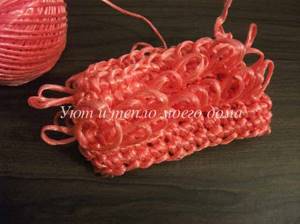
This didn’t suit me, so I took thinner threads.
Here's a skein
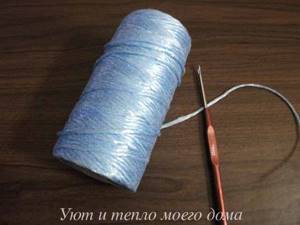
I usually use them for tying tomatoes and flowers.
It is advisable to take a thicker hook, although the knitting will be looser, but the washcloth will not be too hard and pleasant to the touch. I have a hook number 3.7.
How to knit a washcloth: step-by-step description
We collect a chain of air loops twice as long as the width of the future washcloth, and close it into a ring.
We knit one or two rows with single crochets in a circle.
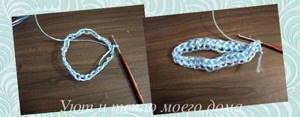
It must be said that knitting from polypropylene threads is not very convenient, since the thread is coarse and even flakes. But what can you do?
We knit the next row with elongated loops.
I only took a photo of the beginning of knitting and a photo of the finished washcloth. How to knit elongated loops, it was very inconvenient to take pictures while simultaneously holding the loop on your hand.
You can watch this video in detail from Natali Korneeva
My longtime regular readers probably remember the gorgeous bedspread made of elongated loops that was at our competition. I am amazed at how much patience and how much work the author of the work, Natalya, put in!
This was my first time knitting with this pattern, because I was not used to it, it was not very convenient to press the elongated loops; at first they turned out to be of unequal length. But then I got the hang of it and, in principle, I knitted a washcloth easily and quickly.
We knit the next row after the elongated loops with single crochets, the next row again with elongated loops. So we alternate the rows. We finish knitting with one or two rows of single crochets.
I crocheted the open edge of the washcloth with half-strips, leaving a hole the size of a piece of soap. It’s easy to place soap inside the washcloth through it. It won’t go anywhere, it won’t fall out, and you don’t need to soap the washcloth, just wet it with water.
Related article: DIY wool quilt: master class for beginners
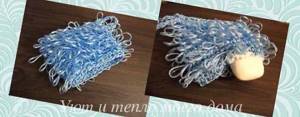
In the corner I also knitted a small loop of chain stitches.
In practice, the washcloth turned out to be quite comfortable and moderately hard.
Such a cute little hedgehog. The view from both sides is exactly the same.
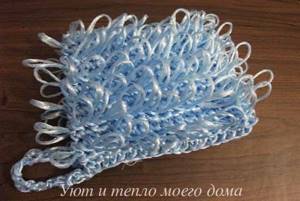
Since my washcloth is unusual and is used along with soap, it is small in size.
But in principle, of course, you can knit a long washcloth, make beautiful inserts from colored stripes, and attach handles (from the same air loops tied with single crochets).
If you don't want a double washcloth, crochet a single washcloth with elongated loops. The principle of knitting is the same, only not in the circle, but in reverse rows. The front row is elongated loops, the purl row is single crochet.
You can also crochet a washcloth without elongated loops using single crochets. For this option, thicker yarn would probably be more suitable.
But that is not all!
Universal option
A universal washcloth should be in every home. Try to diversify it with multi-colored threads.
We collect a chain of 56 air loops and connect it into a ring.
We knit 4 rows with single crochets.
Let's start knitting elongated loops.
And so on until the end of the row.
We knit the next row with single crochets. Alternating the rows in this way, we knit 14 rows.
Then we attach a thread of a different color and knit 7 more rows.
We attach another thread of a different color and knit similarly according to the previous pattern.
We complete our washcloth with 3 rows of single crochets and knit a handle.
Having learned these basic knitting rules, you can experiment, for example, knitting original baby washcloths.
With a spiral pattern
A chain of 47 loops is knitted with a double thread, which is subsequently closed into a ring.

Knitting a washcloth:
- 1st row. Single crochets are knitted into each loop of the chain.
- The 2nd, and all subsequent rows, are knitted with already elongated loops, knitted into each column. After knitting 6 loops, a thread of another color is introduced into the work, and 6 loops are knitted again. The next 6 stitches are knitted again in the first color. And until the end of the row there is an alternation of different colors.
- In each row there is a color shift by 1 stitch. The length of the washcloth can be any. The knitting ends with a row of double crochets.
You can make all the stripes different colors, the width of the stripes can also change.
How to crochet a washcloth for beginners
Not all hand-knitted items are clothing items. You can also tie a washcloth for bathing. After all, yarn can be made not only from wool or cotton, but also from polypropylene, products from which are easy to lather and scrub off the dead skin layers well, and then wash and dry quickly. It is pleasant to wash with such a washcloth.
We will tell you how to crochet a washcloth in a variety of shapes - classic rectangular, mitten-shaped or in the form of various toys filled with foam rubber. Children will find such bathing especially enjoyable, and adults will enjoy using handmade products that are much better than store-bought washcloths.
Durable washcloth
No holes are formed in the proposed washcloth; its loops hold firmly without moving apart. The washcloth is crocheted from special threads for washcloths using crochet number 2 into one thread. The washcloth is knitted on both sides, in the round, for which 30-40 air loops are cast. The width of the washcloth depends on their number. The synthetic thread resembles polypropylene tape, but this does not interfere with crocheting at all.
Having typed the specified number of loops, we connect them into a ring with a connecting post. The next 4-5 rows are knitted with single crochet or single crochet; no pulled loops are formed on these rows. Then comes the turn of the rows with these loops, knitted in such a way that they cannot stretch and disrupt the configuration of the product.
Bathing sponge
The thread that is used to create the washcloth is specifically designed for creating washcloths and rugs; it is made of polypropylene. You can choose a thread of different colors - the color range is quite wide. A carefully knitted washcloth is much more durable than a store-bought one. First of all, a chain of air loops is assembled, twice as long as the width of the future washcloth. You need to knit carefully, not allowing the thread to delaminate.
The edges of the chain are connected to each other, and a handle is immediately knitted for holding a washcloth, made of 3-4 stitches. Everything is told step by step for beginners, all actions are described in detail. After several regular rows, rows with elongated loops are knitted, which are tied around the thumb.
Single layer washcloth
When knitting this washcloth, elongated loops are knitted on both sides. To obtain a more fluffy washcloth, knitting was carried out in two threads. That is, two skeins are used or one, then the second end is additionally pulled from the inside. After casting on an air row of loops, a row of stitches with one crochet is knitted.
The next row is knitted without double crochet. After the third row, we begin knitting with elongated loops, forming them with the thumb. In the last stitch of the row, a single crochet stitch is knitted. After turning the work over, the next row is knitted with similar elongated loops, and they end up on the opposite side of the product.
Double crochet washcloth
The product is knitted in the round and has two layers. Using double crochets allows you to knit a washcloth twice as quickly and at the same time reduce thread consumption. The washcloth turns out to be soft, gentle, and quite comfortable to wash with. Threads to create the product were used in two colors, since the product is made with a gradient.
We knit with two threads using crochet number 5. 35 air loops are cast on and closed with a ring. The next row is knitted with single crochets. Then the elongated loops are knitted with a double crochet. To make the loops elongated, they are formed using the thumb. The stitches knit together very quickly. Subsequent rows are knitted similarly.
Round washcloth for bathing
The washcloth-mitten, made of threads of various colors, resembles a fancy flower. To make it neat and fluffy, we work with one thread. We start with five air loops, which are looped and after one lifting loop are knitted in a circle using single crochets. In the next row, already elongated loops are knitted between the columns of the previous row, securing them with single crochets.
After the air lifting loop, a row is formed with single crochets, increasing their number: one and two stitches are knitted into cells in turn. Then a whole row of elongated loops is knitted again. Gradually other colors are included, and in the photo the washcloth resembles a flower.
Lush loofah
To make the washcloth look fluffy, you need to use a polypropylene thread folded in half. We begin the work with a set of thirty air loops and connect them with a ring. We knit a single crochet into each of the air loops. In the next row, single crochets alternate with single crochets. Then the same pattern is repeated.
In the next row, we knit elongated loops into each of the columns of the previous row. These loops are secured in a row consisting of single crochet stitches. The front side with elongated loops remains on the inside. The alternation of loops is repeated until the required length. Next, the washcloth is turned inside out.
Crocheted washcloth
This master class is designed for those who do not know how to knit at all. The training begins with a story about how to properly hold the hook, ensuring its movement. The initial loops are also described in detail. The result is a chain of air loops, connected by a ring that serves as a cuff for the product. A row of single crochets is formed; five rows is enough.
In the next rows, elongated loops begin to form, which are draped over the thumb. The technique for creating these loops is discussed in detail on the screen. Further rows are knitted exactly the same until the washcloth reaches the specified length. You can change the color of the thread.
Washcloth with a pattern of “Bumps”
The yarn used is double, hook number 5. First of all, 36 chain stitches are cast on, they are connected with a ring, and a row is knitted in single crochets. In the next row, only single crochet stitches are used, then two more similar rows are knitted. Let's start creating the main pattern.
A cone is formed from three yarn overs knitted together. Two stitches are skipped, and another cone of four yarn overs is knitted. The entire row is formed from such cones. This pattern with cones is repeated from row to row. A washcloth made of cones arranged in a checkerboard pattern ends with a cuff made of rows of single crochets.
Tricolor washcloth
The washcloth, painted in the colors of the Russian flag, is knitted from special yarn for washcloths. We cast on 35 loops, this number will determine the width of the washcloth. The chain of loops is closed, and you can start knitting in the round. The first rows are simple, they form the cuff of the washcloth.
Next, elongated loops of the same size begin to form in the rows, which is ensured by throwing each loop over the thumb. After knitting a third of the length of the washcloth, the color changes; another replacement of yarn is made at 2/3 of the full length of the washcloth. Before completing the knitting, two circles of simple loops are knitted to form the cuffs. Next the handle is knitted.
Washcloth without elongated loops
Work begins with a set of 30 air loops. The resulting chain is looped, and two rows are knitted with single crochets. The next row is knitted with single crochets. Next, the main pattern is knitted, consisting of three double crochets, with a gap of two double crochets between them.
The result is a beautiful pattern that also closes into a ring. This three-stitch pattern is repeated on all subsequent rows until the remaining length of the washcloth is knitted. The washcloth ends, as it began, with two single crochets. The washcloth is almost complete, all that remains is to tie the handles.
Bright washcloth
Particularly popular are washcloths with elongated loops, which look nice, are also easy to use and pleasant to the body. This master class will show how you can use a crochet hook to create an interesting, comfortable washcloth. You can also get creative and make it in the shape of a hedgehog for a child. The knitting pattern is quite simple, if you follow the detailed description presented below, you will be able to knit this product quickly and with pleasure. When knitting this item, you must adhere to one rule: while knitting a column, pull out the buttonholes, and knit an additional column without pulling.
Related article: Printing on cardboard and cardboard packaging
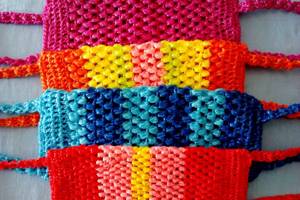
What do we need to work?
- stiff thread, some use thread to tie plants;
- hook size 3.5 to 4.
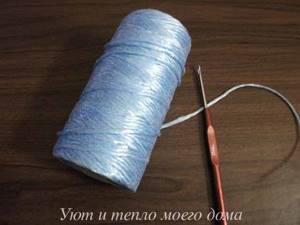
We need to make a chain of six aerials, which we will then connect into a ring using a connecting column.
1st row. We knit 12 single crochets. It turns out that we will knit two single crochets into each buttonhole in the chain.
2nd row. Two chain buttonholes, * one column with an elongated buttonhole, a single crochet to increase the row we knit into the same buttonhole *. As a result, we should have 24 loops.
3rd row. Two chain stitches * one column with an elongated buttonhole, a single crochet we knit into the same loop, a column with an elongated buttonhole *. We knit this way to the very end of the row and get a total of 36 loops.
4th row. Two chain buttonholes, * a column with an elongated buttonhole, again we knit a single crochet into the same loop and then make two columns with elongated buttonholes *. We knit to the very end of the row and get a total amount of buttonholes equal to forty-eight.
5th row. Again we make two chain stitches* one column with an elongated buttonhole, knit a single crochet into the same loop, and then we make three columns with elongated buttonholes* and so we knit until the end of the row and get sixty loops in the row.
6th row. Two chain stitches *one column with an elongated buttonhole, then we knit a single crochet into that loop and increase it by one elongated buttonhole - we extend four*. In this way we knit to the end of the row and we should have 72 loops.
The last row needs to be knitted in single crochets and without adding loops. All that remains is to tie the handle - the width depends on your desire.
Advice! The handle can be made separately and then attached. But it is best to immediately connect the thread with a washcloth and knit from there.
Our bath product is ready.
Related article: DIY wide belt
